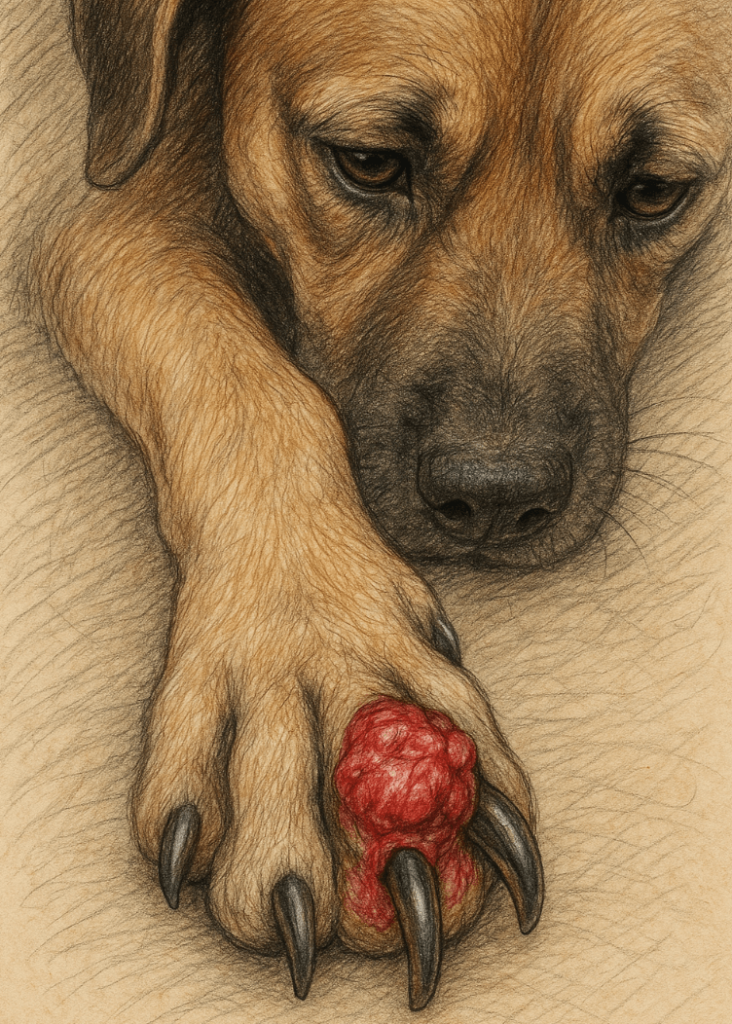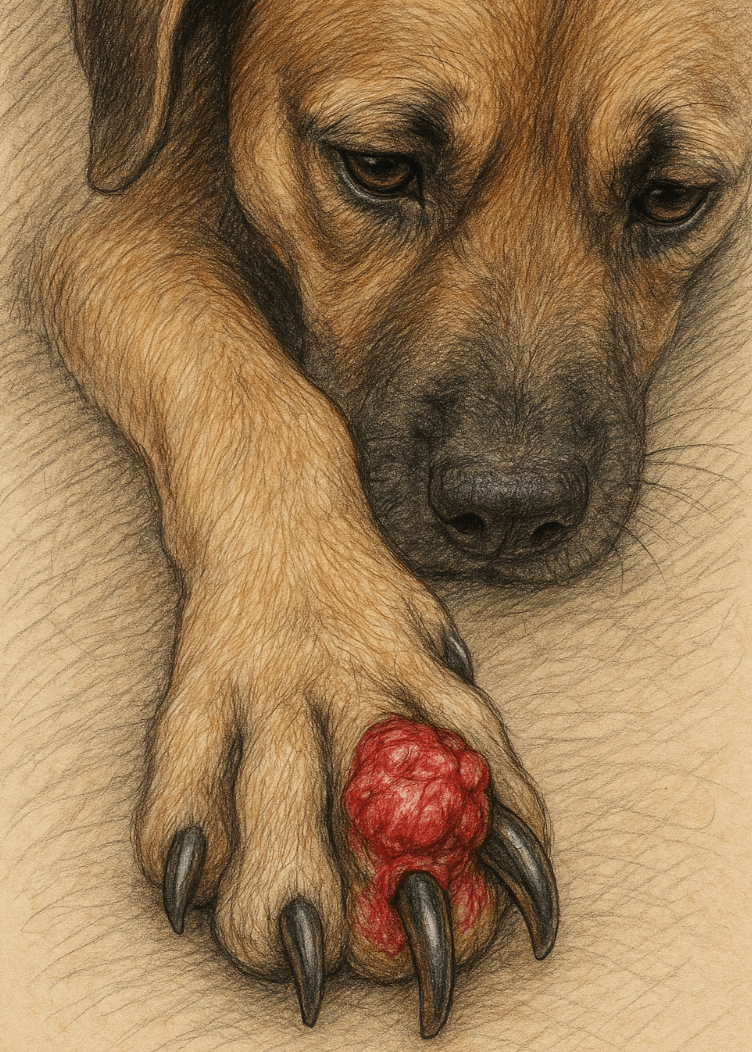Understanding Dog Nail Cancer: Causes, Symptoms, and Treatment
Dog nail cancer, though relatively rare, is a serious condition that can significantly impact your pet’s health and quality of life. This type of cancer typically affects the nail bed or surrounding tissue, leading to pain, discomfort, and potential complications if left untreated. As a responsible pet owner, it’s essential to recognize the warning signs early and understand the available treatment options. In this blog post, we’ll explore everything you need to know about dog nail cancer, from its causes and symptoms to diagnosis, treatment, and prevention strategies. By staying informed, you can ensure your furry friend receives the care they deserve.
Common Symptoms of Dog Nail Cancer
Detecting dog nail cancer early is crucial for effective treatment. Keep an eye out for these common symptoms, which may indicate the presence of this condition.
Swelling Around the Nail Bed:
Persistent swelling or inflammation near the affected nail can be an early sign of cancerous growth.Bleeding or Discharge:
Unexplained bleeding or discharge from the nail area may signal an underlying issue.Lameness or Limping:
Dogs with nail cancer often experience pain, leading to limping or reluctance to put weight on the affected paw.Broken or Deformed Nails:
Frequent nail breakage or deformities without an obvious cause could indicate a deeper problem.Odor or Infection:
A foul smell or signs of infection around the nail bed may accompany advanced stages of nail cancer.
If you notice any of these symptoms, consult your veterinarian promptly for a thorough evaluation. Early detection can make all the difference in managing this condition effectively.
Causes and Risk Factors for Dog Nail Cancer
While the exact cause of dog nail cancer is not always clear, certain factors can increase a dog’s risk of developing this condition. Understanding these risk factors can help you take preventive measures.
Genetic Predisposition:
Some breeds, such as Giant Schnauzers, Bouvier des Flandres, and Kerry Blue Terriers, are more prone to nail cancer due to genetic factors.Age and Lifespan:
Older dogs are at higher risk, as cancer tends to develop more frequently in senior pets.Chronic Trauma or Injury:
Repeated trauma to the nail bed, such as from rough surfaces or improper nail trimming, may contribute to abnormal cell growth.Environmental Factors:
Exposure to carcinogens or toxins in the environment could potentially increase the risk of cancer development.Weakened Immune System:
Dogs with compromised immune systems may be more susceptible to cancers, including those affecting the nails.
By identifying and addressing these risk factors, you can reduce the likelihood of your dog developing nail cancer.
Check this guide 👉How to Stop Dog Nail Bleeding at Home: Best 7 Expert Tips!
Check this guide 👉Do Vets Cut Dog Nails? Best 7 Expert Tips!
Check this guide 👉Is a Dog Nail Scratch Dangerous? Best 7 Health Tips!

Symptoms of Dog Nail Cancer | Treatment Options Available |
|---|---|
Swelling around the nail bed | Surgical removal of the affected tissue |
Bleeding or discharge | Radiation therapy to target cancer cells |
Lameness or limping | Chemotherapy for aggressive cases |
Broken or deformed nails | Antibiotics to manage secondary infections |
Odor or signs of infection | Pain management medications |
Diagnosis Process for Dog Nail Cancer
Diagnosing dog nail cancer involves a series of steps to confirm the presence of cancer and determine its severity. Here’s what you can expect during the diagnostic process.
Physical Examination:
Your veterinarian will examine the affected area, checking for swelling, discharge, or other abnormalities.X-rays or Imaging Tests:
X-rays may be used to assess whether the cancer has spread to nearby bones or tissues.Biopsy of the Affected Tissue:
A small sample of the affected tissue is taken for laboratory analysis to confirm the presence of cancerous cells.Blood Tests:
Blood work helps evaluate your dog’s overall health and detect any underlying conditions that could complicate treatment.Referral to a Specialist:
In complex cases, your vet may refer you to an oncologist for further evaluation and specialized care.
A thorough diagnosis ensures that your dog receives the most appropriate and effective treatment plan.
Treatment Options for Dog Nail Cancer
Treating dog nail cancer requires a tailored approach based on the severity of the condition and your dog’s overall health. Here are the most common treatment options available.
Surgical Removal:
The affected nail and surrounding tissue are surgically removed to eliminate cancerous cells.Radiation Therapy:
High-energy beams target and destroy cancer cells, often used when surgery isn’t fully effective.Chemotherapy:
Medications are administered to kill cancer cells, particularly in cases where the cancer has spread.Pain Management:
Pain-relief medications and anti-inflammatory drugs help improve your dog’s comfort during treatment.Antibiotics for Infections:
Secondary infections are treated with antibiotics to prevent complications and promote healing.
Each treatment option has its own benefits and challenges, so working closely with your veterinarian is essential to determine the best course of action.
Tips for Caring for a Dog with Nail Cancer
Caring for a dog undergoing treatment for nail cancer requires patience and attention to detail. Here are some tips to support your pet during this time.
Keep the Area Clean:
Gently clean the affected paw daily to prevent infections and promote healing.Monitor for Changes:
Watch for new symptoms or worsening conditions, and report them to your vet promptly.Provide Comfortable Resting Spaces:
Ensure your dog has soft, supportive bedding to reduce pressure on the affected paw.Encourage Gentle Exercise:
Light walks or indoor play can help maintain mobility without straining the injured area.Offer Nutritious Food:
A balanced diet supports your dog’s immune system and aids in recovery.
By following these tips, you can create a supportive environment for your dog’s healing process.
Alternative Therapies to Support Traditional Treatment
In addition to conventional treatments, some pet owners explore complementary therapies to enhance their dog’s recovery. These options should always be discussed with your veterinarian.
Acupuncture:
Acupuncture may help alleviate pain and improve circulation in the affected area.Herbal Supplements:
Certain herbs, like turmeric or milk thistle, are believed to support immune function and reduce inflammation.Physical Therapy:
Gentle exercises and massage can aid in restoring mobility and strength after surgery.Cold Laser Therapy:
Low-level laser treatments may reduce pain and promote tissue healing in some cases.Nutritional Adjustments:
Adding omega-3 fatty acids or other supplements can support overall health during treatment.
These therapies can complement traditional treatments but should never replace them without veterinary approval.
Preventive Measures to Reduce the Risk of Dog Nail Cancer
While not all cases of dog nail cancer can be prevented, taking proactive steps can lower your pet’s risk.
Regular Nail Trimming:
Keeping your dog’s nails trimmed reduces the risk of trauma and infection.Inspect Paws Frequently:
Check your dog’s paws regularly for signs of swelling, discoloration, or injury.Avoid Harsh Chemicals:
Limit exposure to pesticides, cleaning products, and other potential carcinogens.Maintain a Healthy Weight:
Obesity can strain joints and tissues, increasing the risk of various health issues, including cancer.Schedule Routine Vet Checkups:
Annual or biannual exams allow your vet to catch potential problems early before they escalate.
By incorporating these practices into your routine, you can help safeguard your dog’s health and well-being.
Frequently Asked Questions About Dog Nail Cancer
Is dog nail cancer curable?
Early detection and treatment can lead to remission, but outcomes depend on the cancer’s stage and aggressiveness.
What breeds are most at risk?
Breeds like Giant Schnauzers, Bouvier des Flandres, and Kerry Blue Terriers have a higher predisposition to nail cancer.
Can nail cancer spread to other parts of the body?
Yes, if left untreated, it can metastasize to nearby tissues or organs, making early intervention critical.
How can I prevent dog nail cancer?
Regular grooming, avoiding trauma to the nails, and monitoring for unusual symptoms can help reduce risks.
What should I do if I suspect my dog has nail cancer?
Schedule an appointment with your veterinarian immediately for a proper diagnosis and treatment plan.
Prioritizing Your Dog’s Health When Facing Nail Cancer
Dog nail cancer is a challenging condition, but with early detection, proper diagnosis, and effective treatment, many dogs can lead happy, comfortable lives. As a pet owner, staying vigilant about your dog’s health and seeking professional guidance when needed is key to ensuring their well-being. Remember, your love and dedication play a vital role in helping your furry companion navigate this difficult journey. By staying informed and proactive, you can give your dog the best chance at recovery and continued happiness.
Understanding Cryptosporidium in Cats: Best 7 Expert Tips! – Spot symptoms, treat safely, and stop parasite spread in your home.
Understanding Cryptosporidium in Dogs: Best 7 Expert Tips! – Learn symptoms, treatment & prevention for this stubborn gut parasite.
Understanding Syringomyelia in Cats: Best 7 Expert Tips! – Recognize signs, manage pain, and support your cat’s neurological health with vet-backed guidance.
Understanding Syringomyelia in Dogs: Best 7 Expert Tips! – Expert insights on symptoms, MRI diagnosis, pain management & quality of life.





